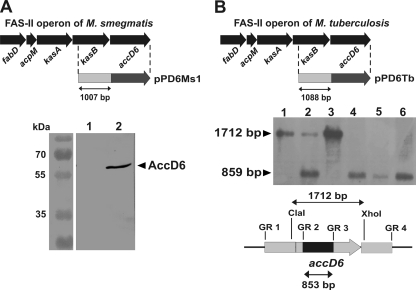Fig. 5.
M. tuberculosis but not M. smegmatis accD6 possesses its own promoter. (A) (Top) Schematic showing the construction of the genetic construct for the complementation of the M. smegmatis ΔaccD6 mutant in order to examine whether accD6 possesses its own promoter (Pacc). The dashed lines indicate the fragment cloned into the integrative vector to produce the pPD6Ms1 construct. (Bottom) Western blot analysis of total crude lysates from the ΔaccD6Msm-Pacc-accD6Msm mutant (lane 1) and wild-type M. smegmatis (lane 2) strains with rabbit anti-AccD6 antibodies. Note the lack of a detectable signal for AccD6 protein expression driven by the 1,007-bp region upstream of the gene. (B) (Top) Schematic showing the construction of the genetic construct for complementation of the M. tuberculosis accD6 SCO mutant in order to examine whether accD6 possesses its own promoter (Pacc). The dashed lines indicate the fragment cloned into the integrative vector to produce the pPD6Tb construct. (Center) Southern blot confirming the deletion of the chromosomal copy of M. tuberculosis accD6 in the ΔaccD6Mtb-Pacc-accD6Mtb mutant, which expressed the accD6 gene exclusively from its own promoter (Pacc). The accD6Mtb gene sequence was used as the probe. Lanes: 1, wild-type M. tuberculosis; 2, single-crossover mutant (SCO); 3, double-crossover mutant carrying the wild-type accD6 gene (wt-DCO); 4 to 6, three independent ΔaccD6Mtb-Pacc-accD6Mtb mutant strains. (Bottom) Map showing the restriction DNA fragment and the size of the internal deletion in the mutated gene. The chromosomal localization of accD6 is represented by the gray arrow and the internal deletion by a black rectangle.

